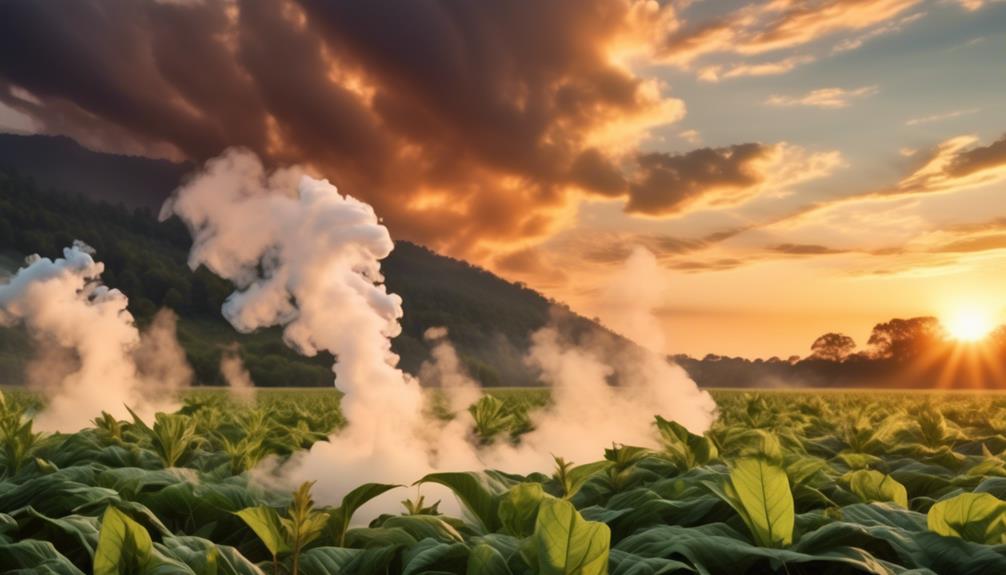
Unlocking the Power of Indigenous Tobacco Practices
Have you ever wondered about the hidden potential of indigenous tobacco practices?
From ancient times, indigenous communities across the world have revered tobacco as more than just a recreational substance. In fact, it has played a vital role in their cultures, traditions, and healing practices.
But what exactly is the power behind this sacred plant? How can we tap into its medicinal properties and unlock its full potential?
Join us as we explore the rich history, cultural significance, and the untapped benefits of indigenous tobacco practices in this enlightening discussion.
Table of Contents
Historical Significance

The historical significance of indigenous tobacco practices lies in their deep-rooted cultural heritage and their enduring impact on communities across generations. Native traditions surrounding tobacco have been passed down through ancestral practices, shaping the identity and spirituality of indigenous peoples. These practices hold immense value and meaning, as they connect individuals to their ancestors, their land, and their cultural roots.
Indigenous tobacco practices are deeply rooted in cultural sensitivity and indigenous knowledge. They reflect a profound understanding of the natural world and the interconnectedness of all living beings. The cultivation, preparation, and ceremonial use of tobacco are integral parts of indigenous traditions, serving as a means of communication with the spiritual realm and a way to honor and connect with ancestors.
Furthermore, these practices carry academic rigor, as they provide valuable insights into the history, social dynamics, and ecological relationships of indigenous communities. They offer a glimpse into the resilience and adaptability of indigenous peoples in the face of colonization and cultural assimilation.
For those seeking a sense of belonging, exploring the historical significance of indigenous tobacco practices can provide a gateway into understanding the rich tapestry of indigenous cultures. By acknowledging and respecting these ancestral practices, we can foster a deeper appreciation for the wisdom and traditions of indigenous peoples, promoting cultural diversity and inclusivity.
Related Article: Why Are Indigenous Tobacco Practices Culturally Significant?
Traditional Tobacco Ceremony
During a traditional tobacco ceremony, participants engage in a sacred ritual that honors their ancestors and fosters a deep connection with the spiritual realm. This ceremony holds a significant historical context within indigenous cultures, dating back centuries or even millennia. Tobacco has been an integral part of indigenous communities’ spiritual practices, serving as a bridge between the physical and spiritual realms.
The traditional tobacco ceremony is rooted in the belief that tobacco is a sacred plant with powerful spiritual properties. It’s often conducted in a ceremonial space, such as a sacred fire circle or a traditional longhouse. Participants come together to offer tobacco as a gift to the spirits and to seek guidance, protection, and healing. The ceremony involves prayers, songs, and the sharing of sacred tobacco.
Through this sacred ritual, participants establish a spiritual connection with their ancestors, who are believed to guide and protect them. The historical context of the tobacco ceremony highlights the long-standing traditions and wisdom passed down from generation to generation. It’s a way for indigenous communities to maintain cultural identity and reinforce their spiritual beliefs.
The spiritual connection fostered during the tobacco ceremony is deeply personal and profound. It allows individuals to tap into their inner selves, connect with their ancestors, and seek guidance from the spiritual realm. This connection brings a sense of belonging and grounding to participants, reminding them of their place within the larger spiritual and cultural tapestry of their community.
Medicinal Properties and Uses
Explore the healing properties of tobacco and its traditional use in remedies passed down through generations.
Discover the cultural significance of tobacco within indigenous communities and how it’s intertwined with their holistic approach to health and well-being.
Gain insight into the profound knowledge and practices that have shaped indigenous tobacco traditions and continue to offer valuable contributions to the field of medicine.
Healing Properties of Tobacco
Indigenous cultures have long recognized the healing properties and medicinal uses of tobacco. Tobacco isn’t only seen as a sacred plant but also as a powerful spiritual tool.
The healing properties of tobacco have been utilized by indigenous communities for centuries, passed down through generations as part of their traditional knowledge. In these cultures, tobacco isn’t solely used for smoking, but also for its medicinal benefits. It has been used to address a wide range of ailments, including respiratory issues, headaches, and digestive problems.
Moreover, tobacco is believed to have the ability to cleanse and purify the mind, body, and spirit. Its smoke is used in ceremonial practices to connect with the spiritual realm and to seek guidance from ancestors.
The healing properties of tobacco hold great significance in indigenous communities, serving as a means of promoting physical, emotional, and spiritual well-being.
Traditional Tobacco Remedies
Tobacco has long been revered for its traditional medicinal properties and diverse range of uses in indigenous cultures. The historical significance of tobacco as a healing remedy is deeply rooted in indigenous traditions, and its cultural preservation is of utmost importance.
Traditional tobacco remedies have been used for centuries to treat various ailments and promote overall well-being. Indigenous communities have passed down this knowledge through generations, ensuring that the medicinal properties of tobacco aren’t lost.
From relieving respiratory issues to soothing insect bites, tobacco has been utilized for its healing properties in diverse ways. Its anti-inflammatory and analgesic qualities have also been recognized, making it an effective remedy for pain relief.
The preservation of these traditional tobacco remedies not only honors the rich cultural heritage of indigenous communities but also provides valuable insights into the power of natural medicine.
Cultural Significance of Tobacco
The rich cultural heritage of indigenous communities is exemplified by the profound medicinal properties and diverse uses of tobacco. Tobacco holds deep spiritual significance for many indigenous peoples, playing a central role in their ceremonies and rituals. It’s believed to have the power to connect individuals with the spiritual realm, serving as a conduit for communication with ancestors and the divine.
Tobacco is used in various indigenous ceremonies, such as prayers, offerings, and purification rituals, where it’s often burned as an offering to the spirits. The smoke is seen as a means to carry prayers and messages to the heavens. Indigenous communities view tobacco as a sacred plant, honoring its role in their traditions and acknowledging its spiritual and healing properties.
Cultural Preservation and Revitalization
To fully appreciate the significance of indigenous tobacco practices, it’s essential to understand the role they play in cultural preservation and revitalization.
Tobacco holds great spiritual, ceremonial, and medicinal value for indigenous communities, serving as a powerful symbol of their identity and connection to the natural world.
Cultural Revival Through Tobacco
Through the practice of cultivating and using tobacco, Indigenous communities have been able to reclaim and revitalize their cultural traditions. Cultural revitalization is at the heart of this process, as Indigenous peoples reconnect with their ancestral knowledge and reclaim their identity.
Traditional practices surrounding tobacco play a significant role in this cultural revival. Tobacco has long held a sacred and ceremonial significance in Indigenous cultures, serving as a means of communication with the spiritual realm and symbolizing unity and respect.
Indigenous Tobacco Practices
Indigenous communities actively preserve and revitalize their cultural heritage through the practice of indigenous tobacco. This ancient tradition holds both historical and cultural significance for these communities. Indigenous tobacco practices date back centuries, serving as a sacred and ceremonial plant. By engaging in these practices, indigenous communities honor their ancestors, maintain a connection to their roots, and pass down traditional knowledge to future generations.
The historical significance of indigenous tobacco practices lies in its role as a symbol of resilience and resistance. Despite centuries of colonization and attempts to erase indigenous culture, the practice of indigenous tobacco has persisted. It serves as a reminder of the strength and perseverance of indigenous peoples throughout history.
Moreover, indigenous tobacco practices hold immense cultural significance. They provide a means for indigenous communities to express their spirituality, connect with the natural world, and maintain a harmonious relationship with the land. These practices foster a sense of belonging and identity, offering a space where indigenous peoples can reclaim and celebrate their cultural heritage.
Indigenous Tobacco and Healing Practices
By incorporating indigenous tobacco practices into healing rituals, you can tap into centuries-old traditions that offer holistic and culturally sensitive approaches to wellness. Indigenous tobacco cultivation and ceremonial tobacco use have long been integral to indigenous healing practices. This ancient knowledge recognizes the power of tobacco as a sacred plant and its ability to connect individuals to the spiritual realm.
For indigenous communities, tobacco is seen as a powerful tool for healing and transformation. It’s believed that tobacco has the ability to cleanse and purify the body, mind, and spirit, allowing for physical, emotional, and spiritual healing. The ceremonial use of tobacco involves offering prayers and intentions while using the smoke to carry these messages to the Creator or the spiritual realm.
Incorporating indigenous tobacco practices into healing rituals provides a sense of connection to ancestral knowledge and a deep respect for indigenous cultures. It recognizes the importance of cultural preservation and the value of indigenous wisdom in addressing health and wellness issues. By embracing these traditions, individuals can experience a sense of belonging and find healing in a way that’s meaningful and authentic to their cultural heritage.
Indigenous tobacco and healing practices offer a unique perspective on wellness, one that honors the interconnectedness of the mind, body, and spirit. By engaging in these practices, you can unlock the power of indigenous knowledge and tap into the wisdom of your ancestors, fostering a sense of belonging and holistic well-being.
Importance of Indigenous Knowledge Transmission
To fully appreciate the richness and significance of indigenous knowledge, it’s essential to understand the pivotal role it plays in the preservation and thriving of diverse cultures around the world. Indigenous knowledge transmission is a vital process that ensures the intergenerational learning and cultural preservation of indigenous communities.
Indigenous knowledge isn’t merely a collection of facts or skills; it encompasses the deep understanding and wisdom that has been passed down through generations. It includes traditional practices, values, beliefs, and ways of knowing that are deeply rooted in the cultural fabric of indigenous peoples. Through intergenerational learning, knowledge is transferred from elders to the younger generation, creating a continuous cycle of cultural preservation.
The transmission of indigenous knowledge is a sacred and holistic process that fosters a sense of belonging and identity within indigenous communities. It’s through this transmission that indigenous peoples maintain their cultural heritage, language, art forms, healing practices, and connection to the natural world. By passing on their knowledge to future generations, indigenous communities ensure the survival and resilience of their cultures in the face of external pressures and challenges.
Indigenous knowledge transmission also promotes a sense of community and cooperation. It fosters a deep respect for the wisdom of elders and encourages younger generations to actively participate in cultural activities and rituals. Through this process, indigenous communities build strong relationships and reinforce the values of reciprocity and collective responsibility.
In a world that’s rapidly changing, the preservation of indigenous knowledge is crucial for the sustainability and well-being of both indigenous peoples and the wider global community. It offers valuable insights and solutions to contemporary challenges, such as environmental degradation, social inequality, and health disparities. By recognizing and honoring the importance of indigenous knowledge transmission, we can contribute to the preservation and celebration of diverse cultures and foster a more inclusive and equitable society.
Frequently Asked Questions
How Did the Use of Indigenous Tobacco Practices Evolve Over Time?
Over time, the use of indigenous tobacco practices has evolved, reflecting the historical significance of these traditions. However, colonization has had a significant impact on these practices, altering and sometimes eradicating them.
Are There Any Specific Rituals or Protocols Associated With the Traditional Tobacco Ceremony?
In traditional tobacco ceremonies, specific rituals and protocols hold great significance. These cultural practices are deeply rooted in indigenous knowledge and reflect the desire for belonging and a sense of cultural identity.
Can You Provide Examples of Medicinal Properties and Uses of Indigenous Tobacco?
Indigenous tobacco has a rich history in traditional healing and holds immense cultural significance. It has been used for various medicinal purposes, such as treating respiratory ailments and providing spiritual guidance.
What Initiatives or Programs Are in Place to Preserve and Revitalize Indigenous Tobacco Practices?
Preserving and revitalizing indigenous tobacco practices is a priority. Programs focusing on cultural significance and sustainable cultivation are in place. By honoring and supporting these initiatives, we ensure the continued strength and vitality of indigenous communities.
How Does the Indigenous Community View the Relationship Between Tobacco and Healing?
In the indigenous community, tobacco is viewed as deeply intertwined with healing. Indigenous tobacco practices and their cultural significance are rooted in traditional healing practices where tobacco is used for spiritual, physical, and emotional well-being.






Leave a Reply